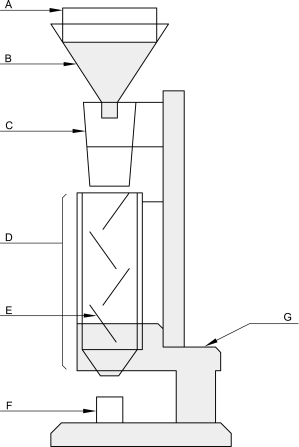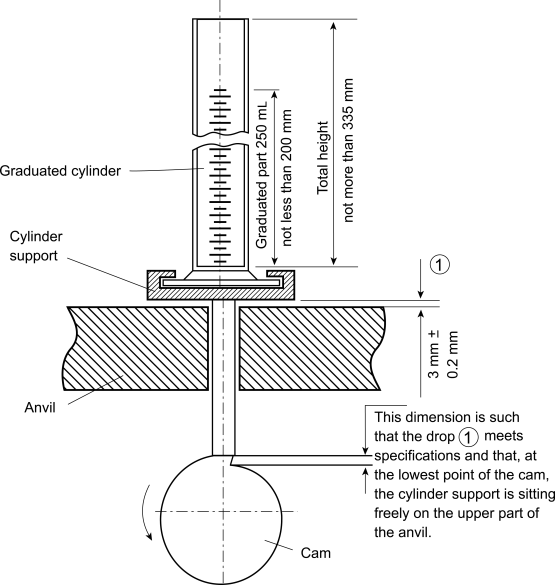Appendix XVII S. Bulk Density and Tapped Density of Powders
Bulk density
The bulk density of a powder is the ratio of the mass of an untapped powder sample to its volume, including the contribution of the interparticulate void volume. Hence, the bulk density depends on both the density of powder particles and the spatial arrangement of particles in the powder bed. The bulk density is expressed in grams per millilitre despite the International Unit being kilogram per cubic metre (1 g/mL = 1000 kg/m3), because the measurements are made using cylinders. It may also be expressed in grams per cubic centimetre.
The bulking properties of a powder are dependent upon the preparation, treatment and storage of the sample, i.e. how it has been handled. The particles can be packed to have a range of bulk densities and, moreover, the slightest disturbance of the powder bed may result in a changed bulk density. Thus, the bulk density of a powder is often very difficult to measure with good reproducibility and, in reporting the results, it is essential to specify how the determination was made.
The bulk density of a powder is determined either by measuring the volume of a known mass of powder sample, which may have been passed through a sieve, in a graduated cylinder (Method 1), or by measuring the mass of a known volume of powder that has been passed through a volumeter into a cup (Method 2) or has been introduced into a measuring vessel (Method 3).
Methods 1 and 3 are favoured.
METHOD 1: MEASUREMENT IN A GRADUATED CYLINDER
Procedure Pass a quantity of powder sufficient to complete the test through a sieve with apertures greater than or equal to 1.0 mm, if necessary, to break up agglomerates that may have formed during storage; this must be done gently to avoid changing the nature of the material. Into a dry, graduated, 250 mL cylinder (readable to 2 mL), gently introduce, without compacting, approximately 100 g (m) of the test sample weighed with 0.1 per cent accuracy. If necessary, carefully level the powder without compacting, and read the unsettled apparent volume (V0) to the nearest graduated unit. Calculate the bulk density in grams per millilitre using the formula m/V0. Generally, replicate determinations are desirable for the determination of this property.
If the powder density is too low or too high, such that the test sample has an untapped apparent volume of more than 250 mL or less than 150 mL, it is not possible to use 100 g of powder sample. In this case, a different amount of powder is selected as the test sample, such that its untapped apparent volume is between 150 mL and 250 mL (apparent volume greater than or equal to 60 per cent of the total volume of the cylinder); the mass of the test sample is specified in the expression of results.
For test samples having an apparent volume between 50 mL and 100 mL, a 100 mL cylinder readable to 1 mL can be used; the volume of the cylinder is specified in the expression of results.
METHOD 2: MEASUREMENT IN A VOLUMETER
Apparatus The apparatus (Figure 2.9.34.-1) consists of a top funnel fitted with a 1.0 mm sieve, mounted over a baffle box containing 4 glass baffles over which the powder slides and bounces as it passes. At the bottom of the baffle box is a funnel that collects the powder and allows it to pour into a cup mounted directly below it. The cup may be cylindrical (25.00 ± 0.05 mL volume with an internal diameter of 30.00 ± 2.00 mm) or cubical (16.39 ± 0.20 mL volume with internal dimensions of 25.400 ± 0.076 mm).
| A. 1.0 mm sieve | E. glass baffle | ||
| B. powder funnel | F. cup | ||
| C. loading funnel | G. stand | ||
| D. baffle box |
Procedure Allow an excess of powder to flow through the apparatus into the sample receiving cup until it overflows, using a minimum of 25 cm3 of powder with the cubical cup and 35 cm3 of powder with the cylindrical cup. Carefully, scrape excess powder from the top of the cup by smoothly moving the edge of the blade of a spatula perpendicular to and in contact with the top surface of the cup, taking care to keep the spatula perpendicular to prevent packing or removal of powder from the cup. Remove any material from the side of the cup and determine the mass (M) of the powder to the nearest 0.1 per cent. Calculate the bulk density in grams per millilitre using the formula M/V0 (where V0 is the volume of the cup) and record the average of 3 determinations using 3 different powder samples.
METHOD 3: MEASUREMENT IN A VESSEL
Apparatus The apparatus consists of a 100 mL cylindrical vessel of stainless steel with dimensions as specified in Figure 2.9.34.-2.
Procedure Pass a quantity of powder sufficient to complete the test through a 1.0 mm sieve, if necessary, to break up agglomerates that may have formed during storage, and allow the obtained sample to flow freely into the measuring vessel until it overflows. Carefully scrape the excess powder from the top of the vessel as described under Method 2. Determine the mass (M0) of the powder to the nearest 0.1 per cent by subtracting the previously determined mass of the empty measuring vessel. Calculate the bulk density in grams per millilitre using the formula M0/100 and record the average of 3 determinations using 3 different powder samples.
Tapped density
The tapped density is an increased bulk density attained after mechanically tapping a receptacle containing the powder sample.
The tapped density is obtained by mechanically tapping a graduated measuring cylinder or vessel containing the powder sample. After observing the initial powder volume or mass, the measuring cylinder or vessel is mechanically tapped, and volume or mass readings are taken until little further volume or mass change is observed. The mechanical tapping is achieved by raising the cylinder or vessel and allowing it to drop, under its own mass, a specified distance by one of 3 methods as described below. Devices that rotate the cylinder or vessel during tapping may be preferred to minimise any possible separation of the mass during tapping down.
METHOD 1
Apparatus The apparatus (Figure 2.9.34.-3) consists of the following:
Procedure Proceed as described above for the determination of the bulk volume (V0). Secure the cylinder in the support. Carry out 10, 500 and 1250 taps on the same powder sample and read the corresponding volumes V10, V500 and V1250 to the nearest graduated unit. If the difference between V500 and V1250 is less than or equal to 2 mL, V1250 is the tapped volume. If the difference between V500 and V1250 exceeds 2 mL, repeat in increments of, for example, 1250 taps, until the difference between successive measurements is less than or equal to 2 mL. Fewer taps may be appropriate for some powders, when validated. Calculate the tapped density in grams per millilitre using the formula m/Vf (where Vf is the final tapped volume). Generally, replicate determinations are desirable for the determination of this property. Specify the drop height with the results.
If it is not possible to use a 100 g test sample, use a reduced amount and a suitable 100 mL graduated cylinder (readable to 1 mL) weighing 130 ± 16 g and mounted on a support weighing 240 ± 12 g. If the difference between V500 and V1250 is less than or equal to 1 mL, V1250 is the tapped volume. If the difference between V500 and V1250 exceeds 1 mL, repeat in increments of, for example, 1250 taps, until the difference between successive measurements is less than or equal to 1 mL. The modified test conditions are specified in the expression of the results.
METHOD 2
Procedure Proceed as directed under Method 1 except that the mechanical tester provides a fixed drop of 3 ± 0.2 mm at a nominal rate of 250 taps per minute.
METHOD 3
Procedure Proceed as described under Method 3 for measuring the bulk density, using the measuring vessel equipped with the cap shown in Figure 2.9.34.-2. The measuring vessel with the cap is lifted 50-60 times per minute by the use of a suitable tapped density tester. Carry out 200 taps, remove the cap and carefully scrape excess powder from the top of the measuring vessel as described under Method 3 for measuring the bulk density. Repeat the procedure using 400 taps. If the difference between the 2 masses obtained after 200 and 400 taps exceeds 2 per cent, repeat the test using 200 additional taps until the difference between successive measurements is less than 2 per cent. Calculate the tapped density in grams per millilitre using the formula Mf/100 (where Mf is the mass of powder in the measuring vessel). Record the average of 3 determinations using 3 different powder samples. The test conditions, including tapping height, are specified in the expression of the results.
Measures of powder compressibility
Because the interparticulate interactions influencing the bulking properties of a powder are also the interactions that interfere with powder flow, a comparison of the bulk and tapped densities can give a measure of the relative importance of these interactions in a given powder. Such a comparison is often used as an index of the ability of the powder to flow, for example the compressibility index or the Hausner ratio.
The compressibility index and Hausner ratio are measures of the propensity of a powder to be compressed as described above. As such, they are measures of the powder′s ability to settle, and they permit an assessment of the relative importance of interparticulate interactions. In a free-flowing powder, such interactions are less significant, and the bulk and tapped densities will be closer in value. For more-poorly flowing materials, there are frequently greater interparticulate interactions, and a greater difference between the bulk and tapped densities will be observed. These differences are reflected in the compressibility index and the Hausner ratio.
Compressibility index:
| V0 | = | unsettled apparent volume; |
| Vf | = | final tapped volume. |
Hausner Ratio:
Depending on the material, the compressibility index can be determined using V10 instead of V0. If V10 is used, it is clearly stated with the results.




